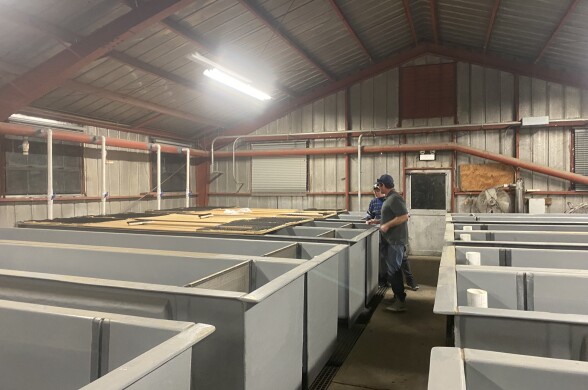Topline:
Hundreds of endangered fish were evacuated from Topanga Creek after the devastating Palisades Fire ripped through the area.
Why it matters: The Southern California steelhead trout survived the flames underwater, but recent rains posed a new threat — localized extinction. Only about 400 of the fish are estimated to remain in Topanga Creek.
Why now: “I'm glad we were able to take action and get those fish out because, you know, our worst fears … kind of came true,” Kyle Evans, environmental program manager with the California Department of Fish and Wildlife, told LAist. The first rain of the year “focused right over Topanga, and the habitat now is completely filled in" with ash and other debris.
The backstory: Wildlife officials went out late last month with nets, buckets and fish-finding contraptions called backpack electrofishers. Their goal: collecting as many trout as possible.
Go deeper: A plan to help Southern California steelhead trout return to habitat.
Read on ... to find out where the fish are for now and what might happen next.
Hundreds of endangered fish were evacuated from Topanga Creek after the devastating Palisades Fire ripped through the area.
The Southern California steelhead trout survived the flames underwater, but recent rains posed a new threat — localized extinction.
Wet weather flushed suffocating sediment, heavy materials and ash from burn-scarred Topanga Canyon into the creek. Officials worried that flows after a major storm would wipe out the fish population, which is estimated to be as low as 400.
Kyle Evans, environmental program manager with the California Department of Fish and Wildlife, told LAist that Topanga Creek is home to the last SoCal steelhead in the Santa Monica Mountains, the species’ historic habitat where it is now considered critically endangered.
“I'm glad we were able to take action and get those fish out because, you know, our worst fears ... kind of came true,” he said. “That storm focused right over Topanga, and the habitat now is completely filled in, frankly.”
The Palisades Fire burned right up to Topanga Creek in some places.
When the rain came, ash and other debris from the burn scar fouled Topanga Creek.
How they saved the fish
Wildlife officials went out late last month with nets, buckets and fish-finding contraptions called backpack electrofishers. Their goal: collecting as many trout as possible.
They wanted to get all of them out of the creek, but Evans admitted that might have been ambitious. In the end, they rescued 271 steelhead trout, more than half the estimated population.
“ I'm happy with the amount of fish we got,” he said. “We weren't able to cover every little bit of the creek just with the amount of time and staff we had, and there's also some areas that are just really deep, beautiful pools that are really hard to get fish out of.”
Using buckets, other tools and their own strength, wildlife officials move fish out of Topanga Creek.
Wildlife officials had been planning for a steelhead rescue operation for years, allowing them to move quickly in the aftermath of the Palisades Fire.
The great trout rescue was on Jan. 23, a few days before the region got its first real round of rain since the wildfires. But it's an operation officials had been preparing for for years.
Southern California has been repeatedly devastated by wildfires, including the 2018 Woolsey Fire, which also impacted the steelhead trout habitat. The department explored ways to protect and potentially move the fish for future disasters, including genetic studies to see how closely they’re all related to one another.
Then the Eaton and Palisades fires broke out.
“As it burned Topanga Creek, it kind of accelerated the process,” Evans said. “You know the things we've been talking about for the last couple years? We got to take action now; this is what we've been preparing for. We got to go get these fish.”
Kyle Evans, environmental program manager with the California Department of Fish and Wildlife, addresses the crew gathered for the trout rescue operation.
Topanga Creek is one of the last steelhead trout habitats in the Santa Monica Mountains.
The Palisades Fire burned all the way to the creek in some places, he said, scorching trees and vegetation along the way.
When storms roll in, the rain can wash large amounts of ash and sediment into the creek, which degrades the water quality. That “muddy, sludgy, gross water” is hard for the trout to breathe in, and Evans said they can suffocate or get crushed.
So the Topanga Creek trout were loaded into huge plastic aquarium tanks and driven to Fillmore Fish Hatchery, which is operated by the California Department of Fish and Wildlife.
Still swimming
Now the fish are being kept in isolated tanks in a separate area so as to not bring in any diseases from the outside.
It ain't Topanga Creek, but the Fillmore Fish Hatchery will have to do until the trout can be released into the wild.
"It's not natural" for the fish to be in tanks, a wildlife official says. So they aim to release the trout in the next couple of weeks.
Officials have tried to make the fish as comfortable as possible — including installing pieces of PVC pipe for places to hide. But the ultimate goal is to get them back into the streams and creeks where they belong.
“ They're not used to being in these tanks," Evans said. "It's not natural for them.”
The hope is to get the SoCal steelhead back swimming freely in the next couple of weeks, but that could be in a different stream. Topanga Creek still needs time to recover.
"They're going to do best," Evans said, "if they're out in the wild."

























